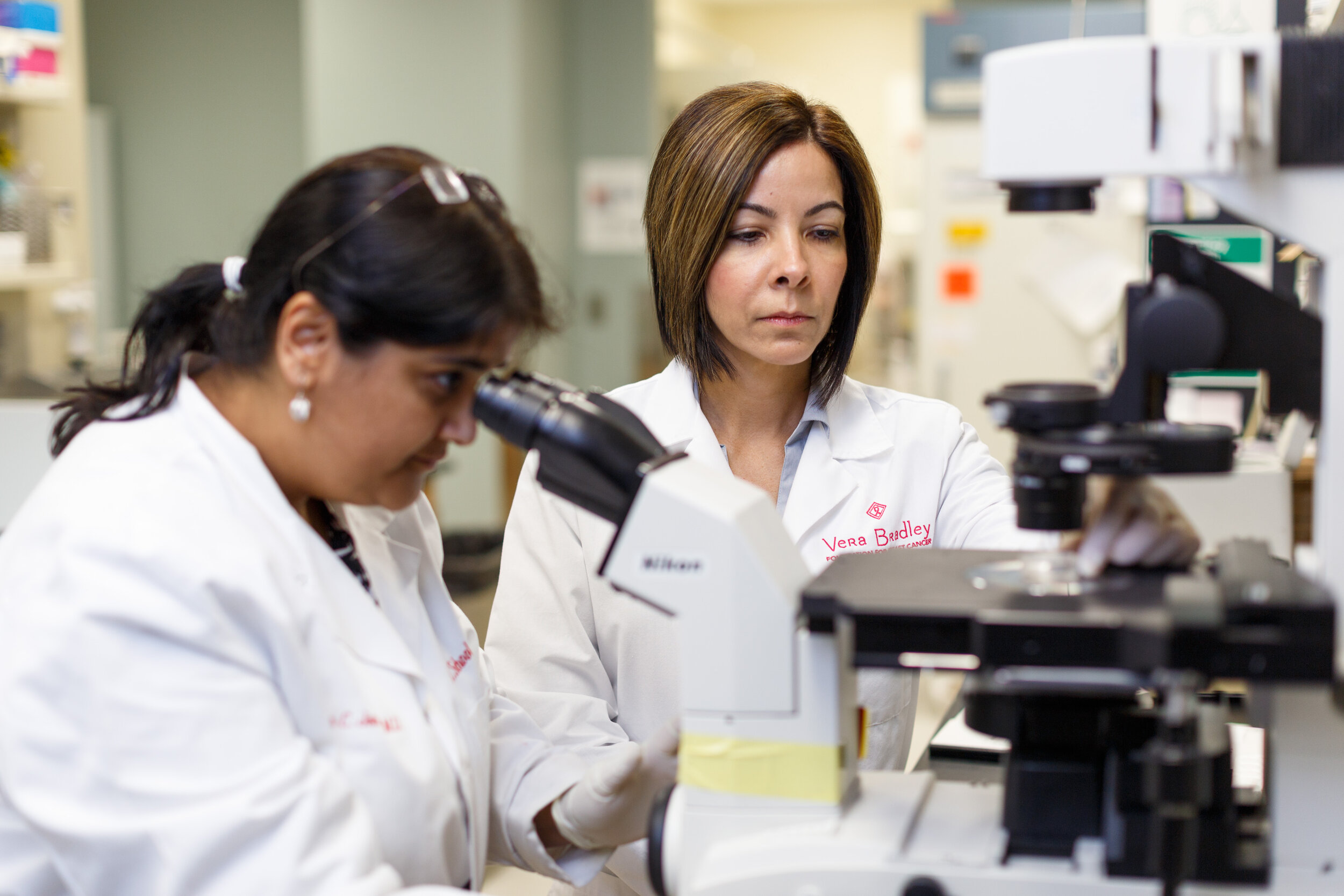Understanding Breast Cancer Research
The robust team of researchers at the Vera Bradley Foundation Center for Breast Cancer Research at Indiana University’s School of Medicine takes a collaborative approach to finding a cure for breast cancer. Each researcher brings a unique area of expertise to the table as they work on different approaches to improve outcomes for each unique breast cancer patient. Just a few of the initiatives they’re currently working on include: prevention and early detection, triple negative breast cancer, new drug development, and health survivorship. Keep reading to learn more about how the research process works.
Laboratory Discovery
The laboratory aspect of research is just one of the many components it takes to develop potential treatments for breast cancer.
For the Vera Bradley Foundation team of researchers, the biomarker discovery is where it all began. Through laboratory work, researchers discovered they could search for distinct targets on a breast cancer cell that could be specifically pinpointed and killed. Instead of submitting all of the cells to radiation treatment, they can now detect and validate biomarkers for a more precise approach to treatment.
The research grants funded by the Vera Bradley Foundation for Breast Cancer afforded the research team the time and resources needed to prove their theories and begin implementation. The funding from the Foundation allows for this initial data to be collected and for scientists to become breast cancer researchers.
After the initial research in the biomarker discovery phase, the focus was shifted to the Monogrammed Medicine phase. This phase includes studying why women respond differently to treatments when they theoretically have the same breast cancer. This is called Pharmacogenetics; it is the study of how people respond differently to drug therapy based upon their genetic makeup or genes. Looking at the DNA signature in a tumor allows researchers to determine what key genes are not responding to treatments. With advanced imaging, researchers are able to see where the drug is penetrating the tumor and understand what is causing it to penetrate some cells but not others.
Understanding the Main Genetic Driver
After treatment, results vary from patient to patient. For some patients, the tumor will be gone. Other patients may still have residual tumors. In these cases, the research team will look at the genome of the original tumor to determine the primary genetic driver. While still in remission, cancer patients begin to receive therapy—a very uncommon practice.
The data that has been collected allows for researchers to know which women will and will not have residual tumors left. Knowing that risk can give patients a better understanding of what lies ahead and peace of mind if they are not likely to recur.
“Funding allows brilliance to thrive.”
Drug development
Drug development that would normally be outsourced to pharmaceutical companies and take upwards of 15 to 20 years can now be done in-house. This is both exciting and essential because in-house drug development allows quicker turnarounds and treatment. The process of collecting data and implementing clinical trials is accelerated, bringing the 20-year timeline down significantly.
The Drug Discovery program at the Indiana University School of Medicine allows researchers to manufacture molecules that will be tested to understand whether or not the patient has active cancer cells. The lead candidates with active molecules will be taken to the clinical trial. This shortened timeline is not only exciting for researchers, but for cancer patients as well. This clinical trial will now be in their lifetime.
Delivery in Clinical Trials
Clinical trials are overseen by the Federal Drug Administration and carried out in three different phases. Phase one focuses on the safety of the drug, phase two focuses on the effectiveness of the drug, and phase three looks at the effectiveness of the drug in a larger group of people. Both the first and second phases include a small group of women, while the third phase includes a group of 3,000+. Funding for the clinical trial phase can go towards many of the different expenses associated with conducting the clinical trial. Expenses like; the cost of the drug, collecting data, imaging, and other various tools and research.
The Vera Bradley Center for Breast Cancer Research has an extensive understanding of drug interactions. Understanding drug interactions along with a comprehensive knowledge of a patient’s genetic makeup, can mean the difference between success or failure for treatment.
Throughout everything, philanthropy has consistently been able to provide the resources needed to complete the research, drug development, and clinical trials. Help contribute to the progress being made at the Vera Bradley Foundation Center for Breast Cancer Research at the Indiana University School of Medicine by donating to the foundation.



